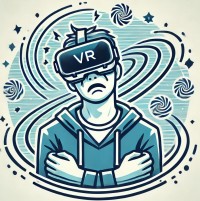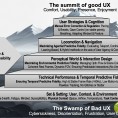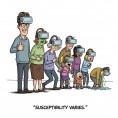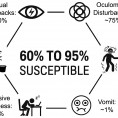
Cybersickness remains a persistent challenge in VR/XR, hindering user experience and adoption. This course bridges research and industry, equipping developers, designers, and researchers with science-backed strategies to mitigate cybersickness through optimized locomotion, interaction, and environment design. Engage with case studies and activities to create more comfortable, accessible VR/XR experiences.
1.5 hour course to be presented at Siggraph 2025 in Vancouver, Canada
Time: Sunday, 10 August 2025 2:00pm — 3:30pm PDT
Location: West Building, Rooms 205–207
for more infos, see Siggraph website https://s2025.conference-schedule.org/presentation/?id=gensub_239&sess=sess192
Course abstract
Cybersickness remains a persistent challenge in virtual and extended reality (VR/XR), affecting user comfort, adoption, and long-term engagement. This course provides developers, designers, and researchers with science-backed strategies for mitigating cybersickness in immersive environments. Attendees will explore theoretical foundations, practical mitigation techniques, and real-world case studies, including locomotion strategies such as HyperJump, leaning-based navigation, and UI/scene optimizations. Through interactive discussions, live polling, and collaborative exercises, attendees will gain a structured understanding of cybersickness causes, measurement, and prevention. The session will conclude with a structured “Do’s \& Don’ts” guide for immediate application in VR/XR projects. This course ensures attendees leave with actionable strategies to enhance XR usability.
Ideal for VR/XR developers, UX designers, and researchers, this course translates scientific insights into practical solutions, equipping attendees with the knowledge and tools to identify, assess, and mitigate cybersickness, thereby enhancing user comfort, engagement, and adoption in their XR projects.
Course Proceedings
The VR Comfort Stack: A Hierarchical Framework for a Systemic Approach to Cybersickness Mitigation
In the process of crafting my Siggraph course I started developing this VR Comfort Stack Framework, see below for abstract and a preprint of the draft framework
Abstract
Despite decades of research, cybersickness remains a significant barrier to the widespread adoption of Virtual Reality (VR). Existing mitigation guidelines are often fragmented, siloed within specific stakeholder domains (e.g., user, developer, or hardware manufacturer), and lack a unifying structure. This fragmentation has contributed to misattributed responsibility for user discomfort. To address this critical gap, we introduce the VR Comfort Stack, a novel hierarchical framework that reframes cybersickness mitigation as a systemic challenge requiring shared responsibility. The framework consists of five interdependent layers, organized around key principles including a central concept of predictive fidelity, where cybersickness is understood as a failure of the system to match the user’s sensory predictions. By assigning clear, synergistic guidelines to users, content creators, providers, hardware manufacturers, and researchers at each layer, the Comfort Stack provides a unified tool for education, design, and future research. This preliminary framework is presented to invite community feedback and to foster a more holistic, systemic, and effective approach to improving VR comfort and accessibility for all.
Updated slides and preview or the VR Comfort Stack Draft Framework I presented at Siggraph 2025
Sorry, there’s no items to display.
VR Sickness benchmark
http://ispace.iat.sfu.ca/project/vr-sickness-benchmark/


